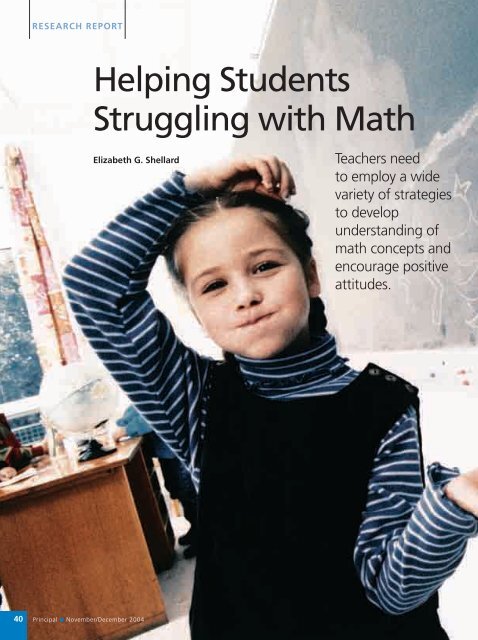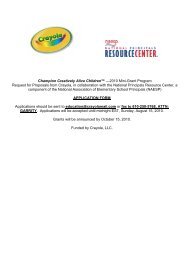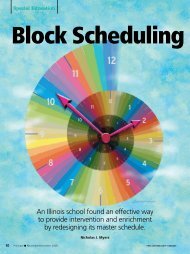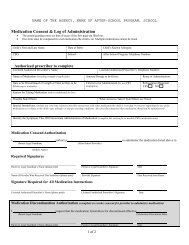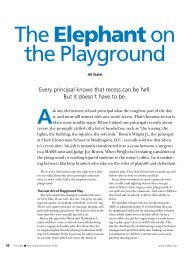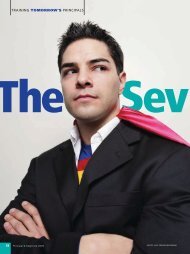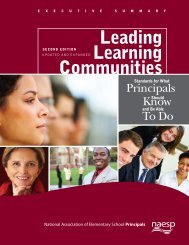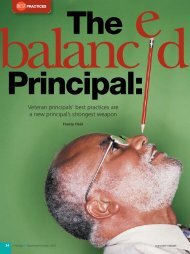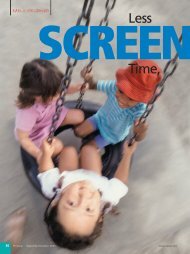Helping Students Struggling with Math - National Association of ...
Helping Students Struggling with Math - National Association of ...
Helping Students Struggling with Math - National Association of ...
- No tags were found...
Create successful ePaper yourself
Turn your PDF publications into a flip-book with our unique Google optimized e-Paper software.
RESEARCH REPORT<strong>Helping</strong> <strong>Students</strong><strong>Struggling</strong> <strong>with</strong> <strong>Math</strong>Elizabeth G. ShellardTeachers needto employ a widevariety <strong>of</strong> strategiesto developunderstanding <strong>of</strong>math concepts andencourage positiveattitudes.40Principal ■ November/December 2004
Their math homeworkincludes errors or isonly partially done—ifat all. They perform poorly onstandardized tests as well asclassroom math tests. <strong>Students</strong>who struggle <strong>with</strong> mathematicsmay do so because they areunable to “see” the largerpicture, make associations, orremember basic facts. Theyneed not only high-qualityIN BRIEFThis report focuses on strategiesteachers can use to help studentsstruggling <strong>with</strong> math. A critical instructionalcomponent is to make surethey understand a skill or concept beforebeing asked to practice it. Adaptinginstruction to a variety <strong>of</strong> learningstyles can be useful, as is encouragingstudents to “think aloud” about howthey approach math problems. Severalstrategies are suggested for studentswho have difficulty <strong>with</strong> basic mathoperations and word problems.teaching, but well-planned instruction explicitly structured todevelop a specific sequence <strong>of</strong> skills. In addition, providing amix <strong>of</strong> direct instruction <strong>of</strong> new skills and concepts, guidedpractice, opportunities for complex thinking and problemsolving,and time for discussion is even more important forthe struggling student than for students in general.BRITT ERLANSON/IMAGEBANKA critical component <strong>of</strong> mathinstruction—particularly crucial forstruggling students—is ensuring thatstudents understand a skill or conceptbefore being asked to practice it. Ashort in-class assignment can helpteachers check for this understanding.But assigning multiple problems to studentswho have only a tenuous understanding—orworse, a misunderstanding—<strong>of</strong> the skill can lead to confusion andfrustration. Teachers should take specialcare in assigning homework tothese students.Teachers can address some <strong>of</strong> theproblems presented by struggling learners,as well as normal differences in skilllevels and developmental levels, throughthe use <strong>of</strong> adaptations or accommodations(Ebeling et al. 1994), many <strong>of</strong>which can be incorporated into regularclassroom instruction. Activities that provideopportunities for students to use avariety <strong>of</strong> learning styles increase thelikelihood that more students will understandthe new concept or skill beingpresented. Here are some approachesthat complement different strengths:Spatial: Using visual clues;Linguistic: Reading word problems;Logical-mathematical: Creating andsolving equations;Kinesthetic: Exploring tactile models;Musical: Creating auditory patterns;Interpersonal: Sharing strategies; andIntrapersonal: Journal writing (Kingand Parker 2001).Developing UnderstandingTeachers working <strong>with</strong> youngchildren know the importance <strong>of</strong>instruction directed toward students’developmental level. This conceptremains important to math instructionthrough all grade levels. It may requiremoving from the concrete to the pictorialto the abstract, <strong>with</strong> opportunitiesprovided for students to actively manipulateobjects or draw graph-like“pictures.” However, “<strong>Students</strong> do notdiscover or understand mathematicalconcepts simply by manipulating concretematerials.... [teachers] must helpstudents focus on underlying mathematicalideas...” (Sutton and Krueger2002)www.naesp.org Principal ■ November/December 2004 41
■ Provide an example <strong>of</strong> a correctlysolvedproblem at the beginning <strong>of</strong>every lesson;■ Have students verbally or visuallyexplain how to solve a problem;■ Introduce only one concept at atime and teach it to mastery;■ Teach in small chunks so that studentsget lots <strong>of</strong> practice, one step at atime;■ Provide learning aids, such ascalculators, to help students focus onconceptual understanding;■ Routinely model the use <strong>of</strong> estimationand have students estimate areasonable solution before starting anycomputation;■ Teach families <strong>of</strong> facts; and■ Demonstrate all concepts <strong>with</strong>manipulatives.Word Problems. Many studentsexperience difficulty <strong>with</strong> word problems(Jarrett 1999). For some, theproblem lies <strong>with</strong> an inability to readand comprehend the problem (Bleyand Thornton 1995). Others have troubledistinguishing relevant from nonrelevantinformation, whereas somecannot translate the words into mathematicaloperations they understand.The following strategies may providestudents <strong>with</strong> different ways to “see”word problems and better grasp theconcepts <strong>of</strong> what is being asked andhow to work toward a solution:Work backward. Give students boththe problem and the answer, then helpthem to develop connections betweenthe words in the problem and their numericrepresentations.Draw and model. Draw a picture ormanipulate objects to form a modelto help students visualize a situation,verbalize abstract ideas, and explainrelationships.Make a table or a graph. Tables andgraphs provide visual means forstudents to organize and summarizenumerical and verbal data.Act it out. Some students learn bestwhen they act out a problem kinesthetically(Krulik and Rudnik 1996; Sorensonet al. 1996).Promoting a Positive AttitudeFinally, because many students whoexperience difficulty in math developnegative attitudes toward the subject,teachers must use good teaching practicesto encourage positive attitudes.Mercer and Miller (n.d.) suggest thefollowing:■ Involve students in setting challengingbut attainable instructional goals;■ Ensure that instruction builds onpreviously learned skills;■ Use progress charts to providestudents <strong>with</strong> feedback on how wellthey are doing;■ Discuss the relevance <strong>of</strong> a mathskill to real-life problems;■ Communicate positive expectationsfor student learning;■ Help students understand howtheir own effort affects achievementoutcomes; and■ Model an enthusiastic andpositive attitude toward math. PReferencesAllsopp, D. H. and Kyger, M. <strong>Math</strong> VIDSManual: Effective Instructional Strategiesfor <strong>Students</strong> Who Have <strong>Math</strong> LearningProblems, 1999. Retrieved from:http://coe.jmu.edu/mathvidsr/metacognitive.htmBley, N. S. and Thornton, C. A. Teaching<strong>Math</strong>ematics to <strong>Students</strong> <strong>with</strong> LearningDisabilities, 3rd Edition. Austin, Tex.:Pro-Ed, 1995.Ebeling, D. G.; Deschenes, C.; and Sprague,J. Adapting Curriculum andInstruction in Inclusive Classrooms: StaffDevelopment Kit. Bloomington, Ind.:Institute for the Study <strong>of</strong> DevelopmentalDisabilities, 1994.Grouws, D. A. “<strong>Math</strong>ematics.” In G. Cawelti(Ed.), Handbook <strong>of</strong> Researchon Improving Student Achievement, 3rdEdition, 162–181. Arlington, Va.:Educational Research Service, 2004.Jarrett, D. The Inclusive Classroom: <strong>Math</strong>ematicsand Science Instruction for <strong>Students</strong> <strong>with</strong>Learning Disabilities. NorthwestRegional Laboratory, 1999. Retrievedfrom: www.nwrel/msec/book7.pdfKing, M. and Parker, C. A Galaxy <strong>of</strong> <strong>Math</strong>ematicsStrategies and Accommodations. University<strong>of</strong> Florida InstructionalTechnology Resource Center, 2001.Retrieved from:www.itrc.ucf.edu/other/fdlrs2001/workshops/math/ppt/mathintro.pdfKline, K. “Early Childhood Teachers Discussthe Standards.” Teaching Children <strong>Math</strong>ematics,May 2000, 570.Krulik, S. and Rudnick, J. A. The New Sourcebookfor Teaching Reasoning and ProblemSolving in Junior and Senior High School.Boston: Allyn and Bacon, 1996.Mercer, C. D. and Miller, S. P. Teaching<strong>Students</strong> <strong>with</strong> Learning Problems in <strong>Math</strong> toAcquire, Understand, and Apply Basic Facts,n.d. Retrieved from:www.enc.org/print/pr<strong>of</strong>essional/learn/eq-uity/articles/document.shtm?input=ACQ-111397-1397_1Sorenson, J. S.; Busckmaster, L. R.; Francis,M. K.; and Knauf, K. M. The Power <strong>of</strong> Problem-solving:Practical Ideas and TeachingStrategies for Any K–8 Subject Area. Boston:Allyn and Bacon, 1996.Sutton, J. and Krueger, A. EDThoughts:What We Know About <strong>Math</strong>ematicsTeaching and Learning. Aurora, Colo.:McREL, 2002.Elizabeth G. Shellard is senior researchspecialist for the Educational ResearchService. Her e-mail address iseshellard@ers.org.WEB RESOURCES<strong>Math</strong> Playground is an Internetsite that contains math games, logicpuzzles, and word problems designedto <strong>of</strong>fer K–6 students entertainingways to practice math skills.www.mathplayground.com/index.html<strong>Helping</strong> Your Child Learn <strong>Math</strong>, developedby the U.S. Department <strong>of</strong>Education, is a guide for parentsthat discusses what it means to be aproblem solver, to communicatemathematically, and to demonstratereasoning ability.www.ed.gov/pubs/parents/<strong>Math</strong>/index.htmlThe executive summary <strong>of</strong> Principlesand Standards for School <strong>Math</strong>ematics,a document from the <strong>National</strong>Council <strong>of</strong> Teachers <strong>of</strong> <strong>Math</strong>ematicsthat outlines the essential qualities<strong>of</strong> an effective mathematics program,is available online.www.ntcm.org/standards/overview.htmwww.naesp.org Principal ■ November/December 2004 43


